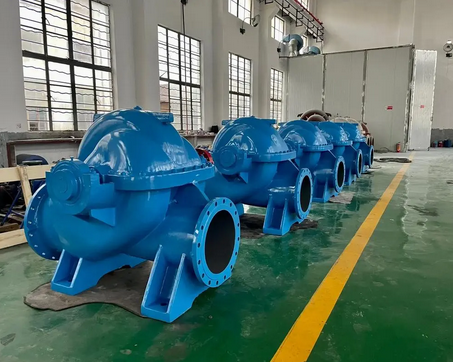Assembly method of double suction pump body and pump cover
The types of leakage of centrifugal pump mechanical seals can be classified according to different reasons and manifestations. The following is a detailed analysis of the types of leakage of centrifugal pump mechanical seals:
1. Leakage during installation and static test
When the mechanical seal is installed and debugged and static test is performed, leakage may occur. The main reasons for this leakage include:
There are problems with the dynamic and static ring seals: such as incorrect seal size, damage or not being pressed.
There are problems between the dynamic and static ring friction pairs: such as uneven contact surfaces, bumps and damage during installation, or foreign objects are caught on the surface.
Improper installation: such as the V-shaped seal is installed in the opposite direction, the set screw is not tightened, the spring seat is retreated, etc.
2. Leakage during trial operation
During the trial operation of the pump, the centrifugal force generated by high-speed rotation will suppress the leakage of the medium, but the leakage that occurs at this time is usually related to the damage of the dynamic and static ring friction pairs. The main reasons include:
Abnormal phenomena such as vacuum, cavitation, and pressure holding: resulting in a large axial force, which separates the dynamic and static ring contact surfaces.
Excessive compression during installation: resulting in severe wear and scratches on the end faces of the friction pairs.
The sealing ring is too tight or too loose: it affects the axial floating amount and sealing effect of the dynamic and static rings.
There are granular substances in the working medium: they enter the friction pair during operation and damage the dynamic and static ring sealing end faces.
3. Sudden leakage during normal operation
The reasons for sudden leakage of centrifugal pumps during normal operation are mostly related to large changes in working conditions or improper operation and maintenance, including:
Vacuuming, cavitation or long-term pressure holding: leading to seal damage.
The actual output of the pump is too small: a large amount of medium circulates in the pump, heat accumulates, causing the medium to gasify, resulting in seal failure.
The reflux volume is too large: it causes the sediment at the bottom of the container on the suction pipe side to rise and damage the seal.
Restarting after a long shutdown: the friction pair is not manually turned and the sealing surface is torn due to adhesion.
The number of corrosive, polymeric and gelling substances in the medium increases: affecting the sealing performance.
The ambient temperature changes sharply: causing changes in the performance of the sealing material.
Frequent changes or adjustments in working conditions: as well as sudden power outages or shutdowns due to failures, etc.
4. Frequent leakage
The reasons for frequent leakage of centrifugal pump mechanical seals may include:
Deformation of the contact end faces of the dynamic and static rings: such as excessive end face pressure, thermal deformation caused by friction heat, etc.
Leakage at the joints of the dynamic and static rings that are installed or bonded: caused by unreasonable installation process, improper materials, etc.
Damage or deformation of the friction pair: leading to failure to run in and cause leakage.
Incorrect selection of sealing ring materials or transmission pins and anti-rotation pins that press against parts after tightening: affecting the sealing effect.
Scale formed between the dynamic and static rings and the sleeve cannot compensate for wear displacement: leading to seal failure.
5. Sudden leakage
Sudden leakage may be caused by the following reasons:
Strong vibration and evacuation of the pump: destroying the friction pair.
Spring breakage or fall-off of the anti-rotation pin: loss of sealing effect.
Failure of the circulation protection system: sudden changes in temperature between the dynamic and static rings cause deformation or cracks on the sealing surface.
6. Other types of leakage
Vibration, heating, smoke, wear: usually related to factors such as end face width, end face pressure ratio, friction pair pairing, cooling effect, lubrication conditions, etc.
Intermittent leakage: may be caused by excessive axial movement of the rotor, the dynamic ring cannot compensate for the displacement in time, etc.





